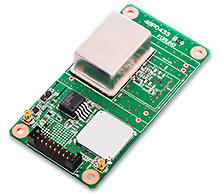Articles for ITS market Utilization vehicle data during disasters
Lack of information in disaster
In August 2021, torrential rains hit many parts of Japan. This was due to the linear rain band. The Japan Meteorological Agency and the Ministry of Land, Infrastructure, Transport and Tourism will hold a joint press conference when a linear rain band is predicted to occur to warn people to take action to protect their lives.
The Cabinet Office has published "Evacuation Information" for various disasters such as river floods, landslides, storm surges, tsunamis, and nuclear disasters, and the revised version was released in May.
However, there is no detailed description of the evacuation method according to the living conditions of the evacuees and the on-site situation at the time of disaster.
In general, when roads are flooded, cars are at risk of floating in the water and becoming impossible to drive.
Therefore, there is a call to avoid using cars. Alternately, the specific decision not to use a car is left to the individual.
Even if it is possible to drive, if some roads are closed due to flooding or landslides, or if there is extreme traffic congestion, it may not be possible to reach the evacuation center.
To avoid such a situation, it is desirable for local governments and police to manage both the information given to residents and the information collected from residents. Examples include information on traffic, weather, actual damage, and emergency response in case of injury.
However, the current situation of disaster information is limited, and the only information available is from local governments' wired broadcasts, SNS, and car navigation systems.
Building the platform
As a part of connected car technology, information management by cars in times of disaster has been discussed by industry groups related to automotive technology and telecommunications.
For example, the Connected Car Technical Committee of The Telecommunication Technology Committee has "V-HUB" as a "telecommunication system using automobiles in times of disaster. This was triggered by the Great East Japan Earthquake that occurred in March 2011.
Since then, a few R&D and demonstration tests have been conducted in Japan on the linkage between smartphones and in-vehicle equipment by Google and APPLE, as well as on next-generation Intelligent Transportation Systems (ITS) using 5G.
However, there is not much experience in the collection and analysis of information using vehicles during disasters, and its utilization based on that information.
Additionally, in recent years, under the concept of Mobility as a Service (MaaS), discussions have begun on a data platform to share information among private cars, public transportation, medical institutions, and local governments.
Although Toyota and NTT have announced that they will begin discussions on the specific creation of a data platform, it is unclear whether this will become a substantial standard in Japan.
Role of Cars in Supporting Disaster Victims
In recent years, cars have been getting attention as a means of supporting disaster victims.
EVs (Electric Vehicles) and FCVs (Fuel Cell Vehicles) will be used as temporary power sources in times of disaster.
For example, Nissan has been working on the Electrify Japan "Blue Switch" since May 2018. More than 100 local governments and local Nissan dealers across Japan have signed cooperative agreements to share EVs and other vehicles free of charge as power sources in times of disaster.
In the case of Toyota, the company dispatched 75 electric vehicles to respond to a disaster in Chiba Prefecture, where a typhoon in September 2019 caused a massive power outage of about 930,000 homes, in response to a request from the government and Tokyo Electric Power Company.
In the future, as electric vehicles become more widespread, there is a possibility that electric vehicles owned by companies and individuals will be used as emergency power sources for the entire region.
To achieve this, it is necessary for local governments to take the lead and for automobile manufacturers and telecommunication-related companies to back them up. This will increase the need for the establishment of a comprehensive information management system in the times of disaster.
Writer introduction

Mr. Kenji Momota Automotive journalist
His major is the world automotive industry and he is also familiar with the energy industry, IT and the aging society problem as the related fields. He acts around the world based in Japan and USA and writes for the general magazines, the technology journals and the automotive related media etc.
He is also commentator of motor race and world's motor show on TV program based on his career of the driver of Indy Racing League and NASCAR. In recent years, he has been covering about a paradigm shift from developed countries to developing countries, the motorized vehicle like EV and the telematics.
FURUNO ITS Journal
Click here for the latest articles after 2022 (in Japanese)2022
- The "realistic" self-driving roadmap shown by the Japanese government and a hands-on report on the latest Subaru EyeSight X
- Will FCVs (Fuel Cell Vehicles) Become Popular? ~New Movement in Toyota and Honda~
- The 'Complete' online sales of new cars start in Japan. Will this new way of buying cars take root?
- Many Firsts! On-Site Report from Tokyo Auto Salon 2022 - The author, who knows what goes on behind the scenes, looks back on 40 years of history. -
2021
- "Moving toward zero traffic fatalities for four-wheeled and two-wheeled vehicles globally in 2050" ~Experience on Honda's latest safety technologies~
- Tsuneishi Shipbuilding's building and DX, an exclusive visit to the main factory
- Japan's Smart City: New Moves toward Practical Use
- When will self-driving buses (service cars) be put to "full-scale" practical use?
- Utilization vehicle data during disasters
- Toyota-led Connected Technology to Transform Commercial Vehicle Business -From light trucks to large trucks and buses-
- Toyota enters the connected car "Personalization" business
- Japanese automakers' carbon-neutral strategies swept up in ESG investment
- Drive experience of the latest autonomous vehicle models and advanced driving support systems
- Will carbon neutrality accelerate the trend to strengthen LCA (Life Cycle Assessment)?
- Semiconductor shortage exposes realities of the automotive industry
- Online Autonomous Driving Contest Enhancing development of Human Resources
2020
- What happens to CASE when gas cars are banned in Japan?
- When will Flying Cars be launched?
- Expectation vs. reality:Autonomous Driving in Japan
- V2X, Becoming increasingly important in autonomous driving
- Technology of Subaru “EyeSight X”
- Lifestyle-oriented French cars gain popularity in Japan
- Human-oriented smart cities are wanted
- MaaS and CASE, how would automotive industry change after COVID-19?
- The beginning of virtualization era, triggered by COVID-19
- Trend of EV shift and consumer demands
- TOYOTA Press conference about ADAS - Releasing algorithm for "sudden acceleration suppression during attempted sudden acceleration" free of charge -
- The Japanese automotive industry in 2020 - 3 turning points -
- "Using a smartphone while driving" and "Level 3 automated driving"
2019
- Motor show business model is at a turning point - Tokyo Motor Show Report -
- Commercialization and monetization of MaaS - ITS World Congress Singapore Report -
- Android Automotive pays attention to V2X - Report from the Frankfurt Motor Show 2019 in Germany -
- Automobile Distribution Revolution and DCM (Data Communication Module)
- Connected business potential and newly proposed "eMaaS" by Honda
- 5G services for practical use are multiplying
- Connectivity technologies attracting attention due to frequent traffic accidents
- Shanghai Motor Show report -SUV, EV, Automated car & 5G-
- Drone Business roadmap and updates to Michibiki (Quasi-Zenith Satellite System)
- MaaS (Mobility as a Service) "town development." Full-scale promotion for a national project
- CES organizer states "Data Period in 2020s." Transformation of the Automotive Industry in CES, US "-CES2019 Report-"
- "Return to Origin" directed towards the age of change, automatic operation and connectivity
2018
- New proposal for Private Car Automated Driving Level and other Hot 5G Technology Topics
- Standardized EV charging infrastructure concerns in Europe, US, Japan and China - Kobe EVS 31 field report -
- Touring a pure car carrier and a test drive of the latest hybrid car
- Planning stage products are exhibited at the newly established visualized mobility service "TOYOTA MOBILITY SHOWROOM".
- Potential “Community Car-share” program promoted by local residents
- CES Asia Report 2108
- Companies attempt new Vehicle-to-Infrastructure communications, including traffic volume measurements and vehicle positioning. -ITS Asia Pacific Forum in Fukuoka-
- Geneva show in Switzerland. Flying cars and MaaS (Mobility as a Service) were hot topics.
- EV (Electric Vehicle) proposals by country
- MaaS competition through service mobilization, M & A and technical field collaboration is accelerating. - The CES 2018 Report -
2017
- Big data’s initiative and fight for the automotive industry. Cooperation among companies becomes increasingly important.
- Connected car and road-to-vehicle communication automatic operation
- ETC (Electronic Toll Collection) and ETC2.0. Current situation and projected future
- Rapid development of sharing economy
- Germany is first to recognize level 3 automated driving
- ITS EU 2017 Field Reports -Automatic Operation and the eCall-
- From Infotainment to ITS, the competitive area is spreading in the car big data industry.
- GTC (GPU Technology Conference) Report and the de facto standardization of AI (artificial intelligence)
- Renesas' new challenge! "e-AI Solution" and "Renesas Autonomy"
- The Automobile industry is shifting from a manufacturing industry to a service industry.
- The movement toward accident countermeasures for aging drivers in Japan
- Fusion of ride sharing and fully automated driving is advancing in the USA.
2016
- Overview of the Quasi-Zenith Satellite System (QZSS) and advancements toward full-scale practical use including the Tokyo Olympic Games - G-space EXPO 2016 report-
- Japan’s automated driving project "SIP-adus" will be a large demonstration experiment.
- The International Home Care & Rehabilitation Exhibition. There were many car manufactures with exhibits booths at this show.
- Japanese car manufacturers starting to concentrate on strengthening the ADAS system
- A new movement of legislation for autonomous cars
- Cyber Security and “AGL”, the new OS for automotive are hot topics in the connected car industry
- “High precision 3D map” the key future of autonomous car and pedestrian dead reckoning
- Chinese “BAT” is accelerating their business in the EV (Electric Vehicle) market
- Tesla's original connection to Taiwan and the new transportation system technologies.
- "The main topic" of the Geneva Motor Show was how to strengthen "pedestrian protection"
- The probe data business is getting more competitive
- Reporting directly from the 2016 CES show "Data services will soon become the main revenue source of automotive industry"
2015
- Do the automated driving systems need the GNSS (Global Navigation Satellite System) ?
- ETC Version 2.0 is coming soon. A new service was announced at the Tokyo Motor Show and the possibility that is could be used as a device for older drivers.
- "Connected Horizon" and "eHorizon". Germany's leading parts supplier accelerates strengthening of "Big Data" for business


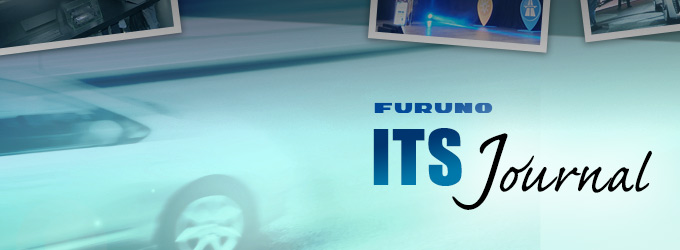
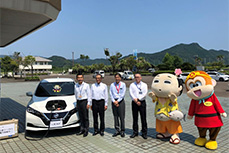 Nissan and Nichinan City in Miyazaki Prefecture announced a disaster cooperation agreement on July 30, 2021. Source: Nissan.
Nissan and Nichinan City in Miyazaki Prefecture announced a disaster cooperation agreement on July 30, 2021. Source: Nissan.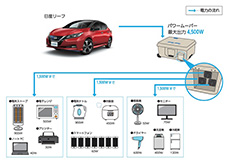 Illustration of the power supply system using Nissan LEAF. Source: Nissan.
Illustration of the power supply system using Nissan LEAF. Source: Nissan.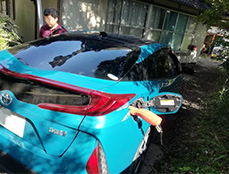 Toyota provided power supply support using plug-in hybrid vehicles and other vehicles in Chiba Prefecture, which was hit by Typhoon in September 2019. Source: Toyota.
Toyota provided power supply support using plug-in hybrid vehicles and other vehicles in Chiba Prefecture, which was hit by Typhoon in September 2019. Source: Toyota. GPS/GNSS Receiver&Chips and Modules (positioning and timing)
GPS/GNSS Receiver&Chips and Modules (positioning and timing)